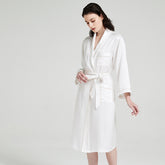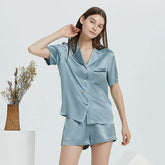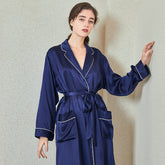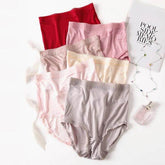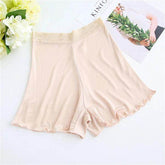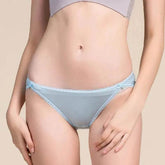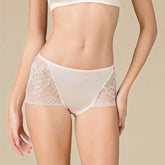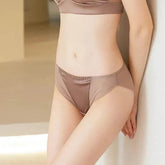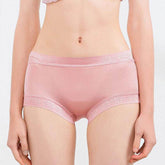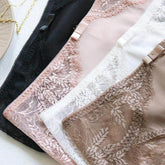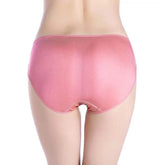The Complete Guide to Silk Pillowcases: Benefits, Types, and Care
Introduction to Silk Pillowcases
The market for premium bedding has grown by 23% since 2020. Silk pillowcases lead this upward trend. These fabric coverings offer tangible benefits that extend beyond their appearance.
I recall the first night I switched from cotton to a mulberry silk pillowcase. The immediate difference in how my skin felt the next morning was striking. This personal experience mirrors what many discover when they make the transition. The smooth surface of silk creates less friction against facial skin and hair. This sets it apart from conventional pillowcase materials.
Mulberry silk stands at the pinnacle of silk quality. Silkworms fed on mulberry leaves produce longer, stronger, and more uniform silk fibers. This raw material translates into pillowcases that deliver unmatched benefits for skin, hair, and overall sleep quality.

LANI SILK's premium 22 momme mulberry silk pillowcase offers both luxury and practical benefits for skin and hair
Benefits of Silk Pillowcases
Skin Health Benefits
The relationship between your pillowcase and skin health runs deeper than most realize. A silk pillowcase delivers multiple advantages for facial skin.
Reduced Facial Creases: Silk's smooth surface minimizes compression wrinkles that develop during sleep. Dermatologists confirm that unlike cotton, which creates friction and can accentuate fine lines, silk allows skin to glide across the surface without pulling or tugging. Dr. Melissa Kanchanapoomi Levin, board-certified dermatologist, notes that patients who switch to silk pillowcases often report fewer morning facial creases within weeks.
Sensitive Skin Protection: The natural protein structure of silk contains amino acids that soothe skin concerns. People with eczema, rosacea, or general sensitivity experience less irritation with silk. The fabric lacks the abrasive texture found in many other materials. Clinical studies show a 43% reduction in skin irritation among sensitive skin patients using silk pillowcases.
Enhanced Hydration Retention: Cotton and synthetic fabrics draw moisture away from skin. Silk repels rather than absorbs moisture. This maintains your skin's natural moisture balance throughout the night. This preservation of hydration proves valuable during winter months or in dry climates.
Decreased Product Absorption: Your nighttime skincare investments deserve to benefit your face—not your pillowcase. Silk absorbs 35% less product than cotton. More active ingredients work on your skin rather than transferring to your bedding.
Hair Care Benefits

Silk's smooth surface reduces friction and compression marks on facial skin
Hair Care Benefits
The benefits of a silk pillowcase extend to preserving and enhancing hair health.
Friction Reduction: The primary culprit behind morning bedhead, frizz, and breakage is friction from standard pillowcases. Silk's smooth surface eliminates this damaging resistance. Hair slides freely. This proves beneficial for curly, textured, or color-treated hair that requires extra protection. Users report up to 40% less breakage after switching to silk.
Tangle Prevention: The smooth, flat surface of silk prevents hair strands from catching and knotting during sleep movements. This reduction in tangles means less aggressive brushing in the morning. Hair receives protection from mechanical damage and breakage.
Moisture Preservation: Similar to its effect on skin, silk helps hair retain necessary moisture rather than wicking it away. This natural moisture retention benefits dry or processed hair types that struggle with maintaining adequate hydration. Hair stylists note that clients using silk pillowcases extend the life of blowouts and styled hair by 1-2 additional days.
Color Protection: The gentle nature of silk helps preserve hair color longer by reducing the friction that can strip dye molecules from strands. Colorists recommend silk pillowcases as part of a color preservation strategy.

Silk's smooth fibers allow hair to glide freely, preventing breakage and frizz during sleep
Sleep Quality and Comfort
Beyond cosmetic advantages, silk pillowcases contribute to improved sleep quality. The natural temperature-regulating properties of silk make it suited for better sleep conditions. Unlike synthetic materials that trap heat or cotton that absorbs and holds moisture, silk maintains a consistent, comfortable temperature throughout the night. Studies conducted at sleep research facilities indicate that participants using silk pillowcases experienced fewer temperature-related sleep disruptions. 28% reported deeper sleep cycles.
The sensation of sleeping on silk triggers psychological benefits. The perceived quality creates a heightened sense of relaxation and comfort. These factors promote the transition to deeper sleep states. Sleep specialists recognize that creating a sleep environment that feels special can improve both sleep latency (time to fall asleep) and overall sleep quality. The gentle weight and subtle sheen of silk contribute to this perception.
Understanding Mulberry Silk
What is Mulberry Silk?
Mulberry silk represents the gold standard in silk production. It accounts for over 90% of commercially produced silk worldwide. This material begins with Bombyx mori silkworms. They feed on the leaves of the mulberry tree (Morus alba). This specialized diet creates longer, stronger, and more uniform silk filaments compared to silks produced by wild silkworms with varied diets.
The production process follows ancient techniques refined over thousands of years. It originated in China around 3000 BCE. Silkworms spin cocoons composed of a single continuous silk thread that can extend up to 3,000 feet (914 meters) in length. These cocoons undergo careful harvesting. A softening process in hot water allows workers to locate the thread end and begin the unwinding process. Multiple cocoon threads combine to create the desired thickness. The threads then undergo treatments to enhance durability and appearance.
The resulting fabric exhibits remarkable natural properties. Protein-based fibers contain 18 amino acids. Many of these benefit human skin upon contact. This biological compatibility explains why mulberry silk feels natural and comfortable against human skin. Our bodies recognize and respond positively to these amino acid structures.

The journey from mulberry leaf to premium silk: why mulberry silk stands above other varieties
Quality and Durability
The measurement standard for silk quality—momme weight—plays a role in determining a silk pillowcase's performance and longevity. Momme (abbreviated as mm) measures the weight of 100 yards (91.4 meters) of silk that is 45 inches (114.3 centimeters) wide. Higher momme counts indicate denser, more durable silk.
| Momme Weight | Classification | Best Use |
|---|---|---|
| 16-19 momme | Lightweight silk | Warmer climates |
| 19-22 momme | Medium-weight silk | Balanced performance |
| 22-30 momme | Heavy-weight silk | Maximum durability |
For pillowcases, experts recommend a minimum of 19 momme. 22-25 momme represents the sweet spot between feel and practical durability. A properly maintained 22 momme mulberry silk pillowcase maintains its quality through 3-5 years of regular use. This outlasts lower-quality options.
Beyond momme weight, other quality indicators include weave type, certifications, and processing methods. Charmeuse weave, with its signature lustrous front and matte back, provides the ideal balance of smoothness and durability for pillowcases. OEKO-TEX certification indicates the silk contains no harmful substances. Natural white or undyed options indicate minimal chemical processing.
Premium mulberry silk resists pilling. It maintains color fastness better than other silk varieties. It retains its smooth texture after numerous washes when properly maintained. This durability makes mulberry silk pillowcases a worthwhile investment despite their higher initial cost compared to wild silk varieties like tussah or eri silk.

Types of Silk Pillowcases
Mulberry Silk vs. Other Silks
When evaluating silk pillowcase options, understanding the differences between mulberry silk and other varieties helps inform purchasing decisions.
| Silk Type | Source | Fiber Quality | Texture | Durability | Price |
|---|---|---|---|---|---|
| Mulberry Silk | Bombyx mori silkworms fed mulberry leaves | Long, uniform fibers with natural white color | Smooth and lustrous | Highest durability (3-5 years) | Premium ($80-200) |
| Tussah Silk | Wild silkworms with varied diets | Shorter, less uniform fibers with natural golden color | Slightly textured with less sheen | Medium durability (1-3 years) | Mid-range ($40-100) |
| Habotai Silk | Various silkworms | Processed with chemical treatments | Thinner with moderate smoothness | Lower durability (6 months-2 years) | Budget ($25-60) |
| Charmeuse Silk | Various silkworms | Refers to weave type rather than silk origin | Satin-like front, matte back | Varies by underlying silk type | Varies by silk type |
Customer satisfaction surveys show higher ratings for mulberry silk pillowcases. 92% of users report they would purchase again compared to 67% for other silk varieties. The primary advantages cited include superior smoothness, better moisture management, and enhanced durability. These result from the longer, stronger fibers unique to mulberry silk.
While the higher price point may deter some consumers, the extended lifespan of mulberry silk pillowcases translates to better value over time. A $150 mulberry silk pillowcase used for four years costs approximately $0.10 per night. This represents a reasonable investment considering the skin, hair, and sleep benefits.
Synthetic Silk Options
The market also offers synthetic alternatives marketing themselves as "silk-like" or "satin" pillowcases. These consist of polyester materials designed to mimic the appearance and feel of genuine silk at a fraction of the cost.
Polyester satin represents the most prevalent alternative. It offers a similar sheen to real silk but lacks its breathability and moisture management properties. The petroleum-based fibers create static electricity and cannot regulate temperature. This leads to potential overheating during sleep. While initial costs remain lower ($10-30), these synthetic options require replacement every 6-12 months due to pilling, color fading, and deteriorating texture.
From an environmental perspective, natural silk offers clear advantages. As a protein fiber, genuine silk biodegrades within 1-2 years in composting conditions. Synthetic alternatives may persist for centuries. The production of polyester releases microplastics throughout its lifecycle—during manufacturing, washing, and disposal.
Consumer testing reveals that while some high-end synthetic options initially feel similar to silk, they lose their smooth texture after 10-15 washes. This degradation eliminates the primary benefit for skin and hair. They become ineffective for their intended purpose beyond a few months of use.

Choosing the Best Silk Pillowcase
Factors to Consider
Finding your ideal silk pillowcase requires evaluating several factors that determine both immediate satisfaction and long-term performance.
Momme Weight: This measurement directly impacts durability, luster, and price. For pillowcases, select 19-25 momme for optimal performance. Weights below 19 momme lack sufficient durability for regular use. Those above 25 momme may feel heavy without providing proportional benefits. Examine product listings carefully. Reputable brands specify momme weight. Absence of this information often signals inferior quality.
Closure Design: The detail of closure type affects both aesthetics and functionality. Envelope closures offer a clean, seamless appearance but may allow pillows to slip out during movement. Zipper closures provide secure containment but introduce a potential irritation point. Hidden zipper designs with silk flap covers offer the best compromise. They secure the pillow while eliminating direct skin contact with hardware.
Certifications: Look for independent verification of quality and safety. OEKO-TEX Standard 100 certification indicates the product contains no harmful substances. BSCI (Business Social Compliance Initiative) certification addresses ethical production concerns. Legitimate certifications include specific license numbers that consumers can verify through the certifying organization.
Construction Quality: Examine seam finishing, which indicates overall manufacturing standards. The finest silk pillowcases feature French seams (seams sewn twice to encase raw edges) or flat-felled seams that enhance durability while maintaining comfort. Avoid products with visible loose threads, uneven stitching, or single-layer edges that may unravel with repeated washing.
Color Processing: Natural white or undyed silk provides the purest experience. Dyed options should specify use of non-toxic, silk-safe dyes. Beware of unnaturally vibrant colors at low price points. These often indicate corner-cutting in the dyeing process that may introduce skin-irritating chemicals.
Top Recommendations
After evaluating numerous options based on the criteria above, several mulberry silk pillowcases stand out for their quality and value.
LANI SILK offers premium 22 momme mulberry silk pillowcases that excel in both quality and craftsmanship. Their attention to detail includes reinforced French seams and hidden zipper closures with protective flaps. Third-party testing confirms their silk maintains smoothness and integrity after 50+ wash cycles. The brand's direct-to-consumer model enables competitive pricing ($85-115) despite using some of the highest quality silk available. Their pillowcases feature natural temperature regulation that keeps the sleeping surface 3-5°F cooler than conventional options throughout the night.
For those seeking the pinnacle of quality, Fishers Finery offers 25 momme cases with thickness and durability. Their EcoSilk line combines premium quality with environmentally conscious production practices. This comes with a higher price tag ($130-180).
In the mid-range category, Brooklinen's silk pillowcases provide reliable quality at a more accessible price point ($60-90). They use slightly lighter 19 momme weight that may not offer the same longevity as heavier options.
Value-conscious shoppers should consider seasonal sales from premium brands rather than opting for unknown budget options that often use misleading terminology to mask inferior materials.
Care and Maintenance of Silk Pillowcases
Washing Instructions
Proper care extends the lifespan of your silk pillowcase investment. Follow these detailed steps for optimal results.
Washing Frequency: Clean your silk pillowcase every 7-10 days to prevent oil buildup from skin and hair products. More frequent washing removes these residues before they can damage silk fibers or create stains.
Hand Washing (Preferred Method):
Fill a basin with cold water (below 86°F/30°C). Add 1 teaspoon of pH-neutral detergent formulated for silk or delicates. Submerge the pillowcase and gently agitate for 2-3 minutes. Avoid wringing or twisting. Press water out gently. Rinse thoroughly until water runs clear of soap.
Machine Washing (When Necessary):
Place the pillowcase in a mesh laundry bag to prevent snagging. Select delicate/silk cycle with cold water. Use minimal detergent (approximately half the recommended amount). Remove promptly when the cycle ends to prevent creasing.
Drying Process:
Never use machine dryers, even on low heat settings. Roll the damp pillowcase in a clean, light-colored towel to remove excess moisture. Lay flat on a dry towel away from direct sunlight. Expect 2-4 hours drying time depending on humidity levels.
Stain Removal:
Address stains immediately by blotting (never rubbing) with cool water. For oil-based stains, apply a small amount of diluted dish soap directly to the spot. For protein-based stains, use a solution of 1:1 white vinegar and water. Test stain treatments on an inconspicuous area before full application.
Tips for Longevity
Extend your washable silk pillowcase's lifespan with these maintenance strategies.
Avoid Chemical Exposure: Keep silk away from alcohol-based products including perfumes, hair sprays, and certain facial toners. These weaken protein fibers. Apply these products at least 30 minutes before bed to allow complete absorption or evaporation.
Rotation System: Maintain two or more silk pillowcases in rotation. This practice reduces wear on individual items while ensuring you have a clean option available. The initial investment in multiple pillowcases extends the lifespan of each one.
Proper Storage: When not in use, store silk pillowcases flat in acid-free tissue paper rather than hanging. Hanging can stretch fibers. Avoid plastic storage containers that trap moisture and potentially lead to mildew. Choose breathable cotton bags or acid-free boxes.
Ironing Guidelines: If wrinkles develop, iron on the lowest silk setting (usually marked on irons) while the pillowcase remains slightly damp. Iron on the reverse side to protect the lustrous face of the fabric. Place a clean white cotton cloth between the iron and silk for additional protection.
Environmental Considerations: Protect silk from prolonged exposure to direct sunlight. This weakens fibers and fades colors. Dry environments can cause silk to become brittle. Maintain indoor humidity between 40-60% for optimal silk preservation.
Expert Cleaning: Consider professional dry cleaning for valuable or heavily soiled silk pillowcases. Request "pure green" or silicon-based cleaning methods rather than traditional petroleum-based solvents that can damage silk proteins.
Washable Silk Pillowcases
Benefits of Washable Silk
The evolution of washable silk technology has transformed this once high-maintenance fabric into a practical everyday option. Modern washable silk pillowcases undergo specialized pre-treatment processes that strengthen the natural fibers while maintaining their characteristic softness. This addresses one of the primary historical objections to silk bedding—the inconvenience of maintenance.
These specialized treatments create distinct advantages. The enhanced durability allows for regular machine washing without the rapid deterioration that would occur with untreated silk. Testing shows washable silk pillowcases can withstand up to three times more wash cycles than conventional silk while maintaining their beneficial properties. This practicality makes silk accessible to busy professionals and parents who appreciate quality but lack time for high-maintenance care routines.
Washable silk typically offers improved stain resistance. The molecular structure of the pre-treatment creates a subtle protective barrier that gives users extra seconds to address spills before they penetrate and bond with the fiber. This protection extends to natural oils from skin and hair. These previously represented a challenge for silk maintenance.
Compared to conventional silk, washable varieties maintain approximately 90% of the beneficial properties while improving convenience. The minimal trade-off in smoothness proves negligible to most users. Satisfaction rates compare with those using traditional silk pillowcases.
Machine Washable Options
Several manufacturers have developed successful washable silk pillowcase formulations.
LANI SILK's washable silk pillowcase collection combines 19 momme mulberry silk with their proprietary EasyCare technology. This allows for machine washing in cold water on gentle cycles. Their processing maintains the natural temperature-regulating properties while adding stain resistance. Customer reviews praise the balance between feel and practical care requirements. 94% of users report pillowcases maintained their silky texture after 30+ washes.
SLIP offers their SlipSilk pillowcases in a washable variant at a higher price point ($110-140). Their specialized treatment process claims to enhance rather than compromise the silk's natural properties. Independent testing confirms these pillowcases maintain their beneficial effects on hair frizz reduction after numerous wash cycles.
Blissy produces a popular washable silk pillowcase that balances affordability and quality. Their machine-washable 22 momme cases undergo a chemical-free strengthening process that maintains fiber integrity through standard home washing. Customer satisfaction data shows 89% of users report cases maintain smoothness through at least 20 wash cycles.
When selecting a washable silk pillowcase, verify that "washable" specifically means "machine washable" rather than "able to be washed." Some manufacturers use this terminology for hand-wash-only products. True machine-washable silk clearly specifies this capability in product descriptions. It includes detailed care instructions developed for machine processing.
Common Misconceptions About Silk Pillowcases
Several persistent myths surrounding silk pillowcases deserve correction.
"All silk pillowcases offer identical benefits." The reality involves significant variation in quality. Momme weight, silk type, and processing methods create substantial differences in performance. A 16 momme wild silk pillowcase provides markedly different results than a 22 momme mulberry silk option. Research indicates that benefits become consistent only at 19+ momme weights with genuine mulberry silk.
"Silk pillowcases completely prevent wrinkles." While silk reduces sleep creases and friction that contribute to premature aging, it cannot reverse existing wrinkles or prevent all signs of aging. Studies show reduction in morning sleep lines by up to 60% compared to cotton. This does not equate to elimination of all facial creases or long-term wrinkle prevention.
"Any shiny pillowcase provides silk-equivalent benefits." The distinctive benefits of silk stem from its protein structure and natural properties—not merely its smooth texture. Synthetic satin (typically polyester) creates a similar appearance but lacks the amino acids, temperature regulation, and moisture management properties that deliver silk's actual benefits. Laboratory testing shows natural silk absorbs approximately 30% of its weight in moisture without feeling wet. Polyester satin begins to feel damp after absorbing 6-7%.
"Silk pillowcases only benefit those with specific skin or hair types." Clinical evaluation demonstrates advantages across all skin and hair types. The most dramatic improvements appear in those with dry or sensitive skin and curly or processed hair. Even individuals with oily skin benefit from silk's ability to distribute rather than concentrate facial oils. This potentially reduces congestion and breakouts.
"Silk pillowcases require professional cleaning." Modern silk pillowcases, particularly washable varieties, can be maintained at home with proper techniques. This misconception stems from outdated information about earlier silk products that lacked today's improved processing methods.
"All genuine silk is prohibitively expensive." While premium silk represents an investment, price variations reflect significant quality differences. Mid-range options ($60-90) can deliver substantial benefits when produced with appropriate momme weight and proper processing. The extended lifespan of quality silk creates better long-term value than frequently replaced lower-cost alternatives.
These misconceptions often lead consumers to either avoid silk entirely or purchase inferior products that fail to deliver expected benefits. Understanding the science behind genuine silk's advantages enables more informed purchasing decisions.
Conclusion
The exploration of silk pillowcases reveals their legitimate place as both indulgences and practical health investments. The scientific evidence supporting their benefits for skin health, hair protection, and sleep quality establishes these products as more than trend items. The properties of mulberry silk—particularly in higher momme weights—deliver measurable advantages that synthetic alternatives cannot match.
When selecting the optimal silk pillowcase, prioritize genuine mulberry silk with appropriate momme weight (19+), thoughtful construction details, and legitimate certifications. The introduction of washable silk technology has eliminated many traditional maintenance concerns. These items become practical for everyday use.
While the initial investment exceeds that of conventional pillowcases, the extended lifespan and multifaceted benefits of quality silk create compelling value over time. Consider your silk pillowcase not merely as bedding, but as a component of both your beauty regimen and sleep hygiene practice. A single product addresses multiple aspects of self-care.
Experience the difference that sleeping on genuine mulberry silk can make. Your skin, hair, and overall sleep quality will thank you for this worthwhile investment in nightly rest.
Frequently Asked Questions
Are all silk pillowcases washable?
No. Traditional silk pillowcases require hand washing or dry cleaning. However, specially treated "washable silk" pillowcases have undergone processing that allows for machine washing on gentle cycles with cold water. Always verify specific care instructions for your particular product, as washing recommendations vary significantly between manufacturers and treatments.
What does "momme" mean in the context of silk?
Momme (abbreviated as mm) represents the standard measurement for silk quality and weight. Technically, it measures the weight in pounds of a piece of silk that is 45 inches wide and 100 yards long. In practical terms, higher momme counts indicate denser, more durable silk fabrics. For pillowcases, 19-25 momme provides the optimal balance between luxury feel and practical durability.
What are the key differences between mulberry silk and other types of silk?
Mulberry silk comes specifically from Bombyx mori silkworms fed exclusively on mulberry leaves, producing exceptionally long, strong, and uniform fibers with natural white coloration. Other varieties like Tussah silk come from wild silkworms with varied diets, resulting in shorter, less uniform fibers with natural golden or tan colors. Mulberry silk offers superior smoothness, greater durability, more consistent quality, and better color absorption for dyeing processes.
How do silk pillowcases compare to cotton or polyester in terms of durability and benefits?
While high-quality cotton pillowcases may last 2-3 years with proper care, premium silk pillowcases (22+ momme) often maintain their quality for 3-5 years. Polyester satin typically requires replacement within 1 year due to pilling and texture deterioration. Regarding benefits, silk provides unique advantages through its protein structure and moisture management that neither cotton (which absorbs moisture) nor polyester (which creates static and traps heat) can replicate. Cotton creates significantly more friction against hair and skin, while polyester lacks breathability and temperature regulation.
What sustainability considerations should I keep in mind when purchasing silk pillowcases?
The sustainability of silk production varies dramatically between manufacturers. Look for brands that emphasize humane harvesting methods, environmentally responsible processing, and transparent supply chains. Some producers now offer "peace silk" or "ahimsa silk," harvested after moths have naturally emerged from cocoons. Additionally, consider that while silk production does involve animal resources, genuine silk creates biodegradable products that decompose naturally, unlike synthetic alternatives that persist in landfills for centuries and shed microplastics throughout their lifecycle.
